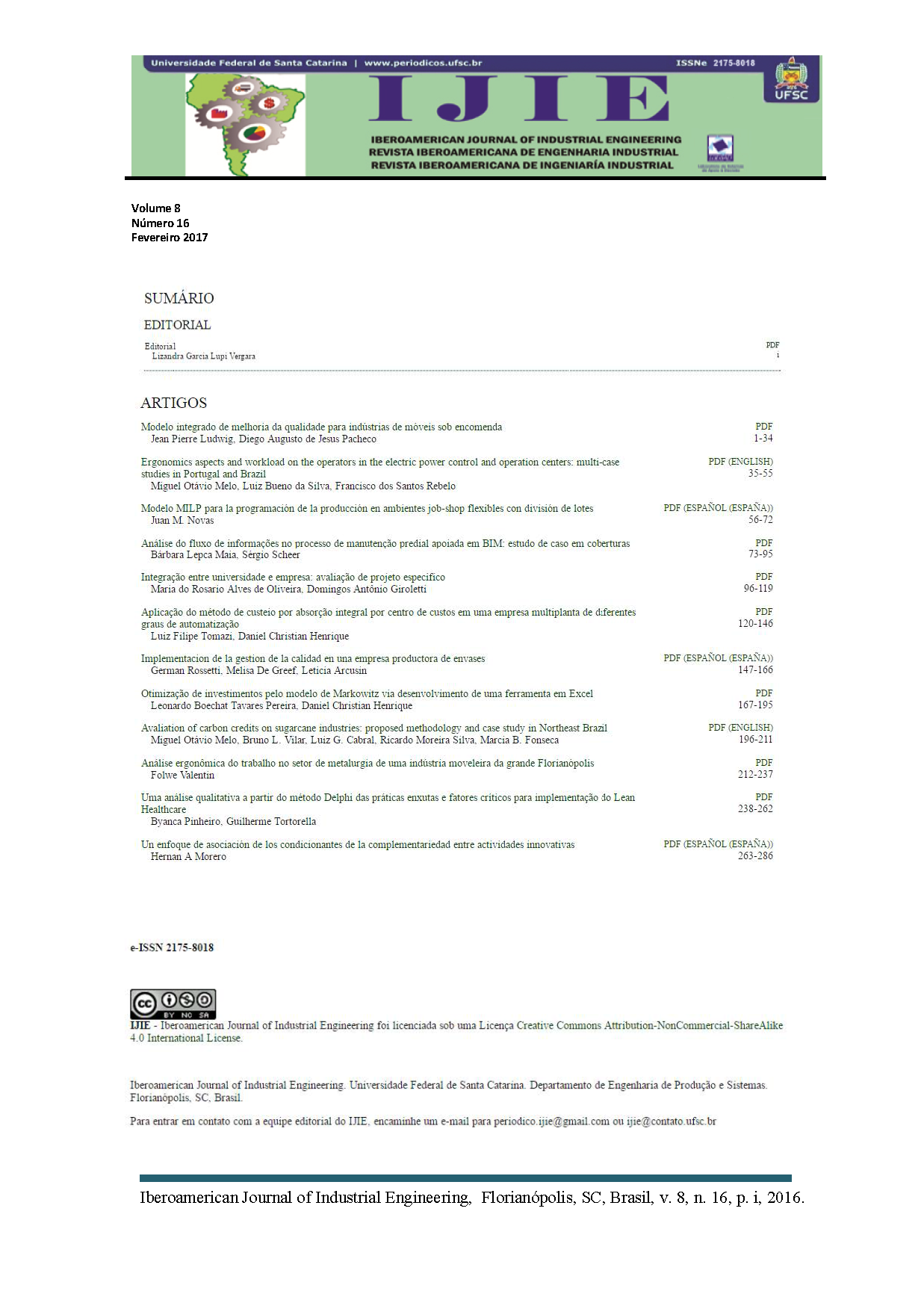Avaliation of carbon credits on sugarcane industries: proposed methodology and case study in Northeast Brazil
Palavras-chave:
Clean Development Mechanism, Carbon Credits, Sustainability in the sugarcane industries, Energy Efficiency.Resumo
The market for Carbon Credits presents itself as a source of obtaining financing for agribusiness industries, providing a new source of financial operations capable of generating an expansion of cash flow. These financial resources could be via marketing products through the use of Green Marketing, or simply employing aspects of social and environmental responsibility. The main companies in Brazil are the sugar mills, paper, pulp, timber accompanied to a lesser extent by government initiatives. Even registering a considerable amount of negotiation is still a largely unexplored market for the sugarcane and the alcohol sector. The purpose of this paper is to present a methodology for evaluation of carbon credits in the sugarcane industry estimating the financial potential of these projects, and present a case study in Northeast Brazil. There is a potential volume of carbon credits the company's annual turnover U$ 170 million in the case study analysed.
Referências
Teske, S.; Pregger, T.; Simon, S.; Naegler, T.; Graus, W.; Lins, C. (2011). Energy [R]evolution 2010—a sustainable world energy outlook. Energy Efficiency, vol. 4, pp.409–433. doi: 10.1007/s12053-010-9098-y
Rosenow, J. (2013).The politics of the German CO2-Building Rehabilitation Programme. Energy Efficiency. vol. 6, pp 219-238. doi.10.1007/s12053-012-9181-7
Sands, R.; Schumacher, K. (2009).Economic Comparison of Greenhouse Gas Mitigation Options in Germany. Energy Efficiency, vol. 2, pp 17-36. doi.10.1007/s12053-008-9031-9
Mills, E.; Jacobson, A. (2011). From Carbon to Light: A New Framework for Estimating Greenhouse Gas Emissions Reductions from Replacing Fuel-Based Lighting with LED systems. Energy Efficiency, vol.4, pp 523-546. doi.10.1007/s12053-011-9121-y
Martinez, C.; Silveira, S. (2013). Energy efficiency and CO2 emissions in Swedish manufacturing industries. Energy Efficiency, vol. 6, pp. 117-133, doi.10.1007/s12053-012-9159-5
Mlecnick, E. (2012).Defining Nearly Zero-Energy Housing in Belgium and the Netherlands Energy Efficiency, vol. 5, pp 411-431.doi.10.1007/s12053-011-9138-2
Raux, C. (2010).The Potential for CO2 Emissions Trading in Transport: the Case of Personal Vehicles and Freight. Energy Efficiency, vol. 3, pp 133-148. doi.10.1007/s12053-009-9065-7
Ürge-Vorsatz. D.; Novikova, A.; Köppel, S. (2009). Bottom–Up Assessment of potentials and Costs of CO2 Emission Mitigation in the Buildings Sector: Insights into the Missing Elements. Energy Efficiency, vol. 2, pp 293-316. doi.10.1007/s12053-009-9051-0
Mills, E. (2011). Building Commissioning: A Golden Opportunity for Reducing Energy Costs and Greenhouse Gas Emissions in the United States. Energy Efficiency. vol. 4, pp 145-173. doi. 10.1007/s12053-011-9116-8
Raux, C.; Lee-Gosselin, Martin E.H. (2010).Transport, energy and greenhouse gases: perspectives on demand limitation. Guest editorial. Energy Efficiency, vol. 3, pp 111-113. doi.10.1007/s12053-009-9068-4
Berry, S.; Davidson, K.; Saman, W. (2013) Defining Zero Carbon and Zero Energy Homes from a Performance-Based Regulatory Perspective. Energy Efficiency August 2013. doi.10.1007/s12053-013-9225-7
Giometti, A. Moreira, H (2008). Kyoto Protocol and the possibilities of insertion of Brazil in the Clean Development Mechanism through projects in clean energy (in Portuguese). Contexto int. [online]. vol.30, n.1, pp. 9-47. ISSN 0102-8529.
Gallaher, M.; Delhotal, K.; Petrusa, J. (2009) Estimating the Potential CO2 Mitigation from Agricultural Energy Efficiency in the United States. Energy Efficiency. vol 2, pp 207-220.
doi. 10.1007/s12053-008-9039-1
Vendrusculo, E.; Queiroz, G. (2009). Life Cycle Cost Analysis of Energy Efficiency Design Options for Refrigerators in Brazil. Energy Efficiency, vol. 2, pp 271-286. doi. 10.1007/s12053-008-9034-6
Melo, Miguel O. B. C. ; Campelo, S.; Silva, L. (2012). Industries energy efficiency analyses in northeast. brazil: Proposal of methodology and case studies. International Journal of Industrial Engineering: Theory, Applications and Theory.vol. 18, n. 9.
Ecosystem Marketplace and Bloomberg. (2011). New Energy Finance. Developing Dimension: state of the voluntary Carbon markets 2012. New York.
Seiffert, M. (2009).Carbon Market and the Kyoto Protocol: Business Opportunities in Search of Sustainability (in Portuguese). São Paulo: Atlas. Brazil
Hiratsuka, A. (2009). Analysis of environmental and economic impacts on multimodal transport. (MSc Dissertation) (in Portuguese), University State Paulista, Faculty of Engineering Ilha Solteira, 2009.
Oliveira, A.; Rubim, R.;Fernandes, P.; Prellwitz, W.; Azevedo, P. (2011).Economic evaluation of cane sugar-tillage compared to conventional in Goytacazes-RJ (in Portuguese). Review Vértices, vol. 13
Fairbairn, M.; Paula, T.; Cordeiro, G.; Americano, B.; Filho, R.T. (2012). Evaluation of partial clinker replacement by sugar cane bagasse ash: CO2 emission reductions and potential for carbon credits. Review IBRACON de Estruturas e Materiais, vol. 5.
Buckeridge. M. (2007) Carbon sequestration, cane sugar and Cinderella Effect (in Portuguese). Revista Eletrônica de Jornalismo CientÃfico com Ciência. n° 105.
Mantovani, E.C.; Maldonado, M.R.; Antonio, A.C. et al . (2012). Carbon Credit: Sustainable Investment (in Portuguese). Review Alumni, vol.2.
Downloads
Publicado
Como Citar
Edição
Seção
Licença
Os artigos publicados são de propriedade do IJIE – Iberoamerican Journal of Industrial Engineering, Revista Iberoamericana de Engenharia Industrial, Revista Iberoamericana de Ingeniería Industrial. Os autores são os responsáveis pelos conteúdos dos artigos. O IJIE não se responsabiliza ou endossa as opiniões emitidas pelos autores dos textos publicados, salientando que as opiniões são de exclusiva responsabilidade dos autores.
O periódico se reserva o direito de introduzir alterações no original, visando a manter a homogeneidade e a qualidade da publicação, respeitando, no entanto, o estilo e as opiniões dos autores. Essas alterações serão editoriais (correções gramaticais e adequações estilísticas) e não substanciais, de forma que não modifiquem o sentido do texto. As provas finais não serão enviadas aos autores, sendo o artigo publicado com os ajustes necessários.
Conforme citado neste site, no item “Caráter do IJIE”, os artigos são de uso gratuito, com atribuições próprias em aplicações educacionais e não-comerciais. Uma nova publicação do mesmo texto, de iniciativa de seu autor ou de terceiros, fica sujeita à expressa menção da precedência de sua publicação neste periódico, citando-se a edição e a data dessa publicação.

